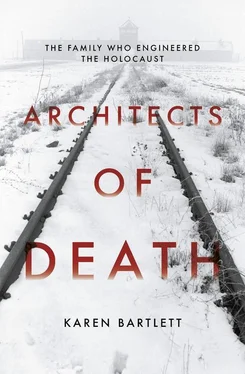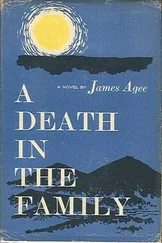In January 1943, much anguished communication ensued over a missing blower for the ventilation system for the gas chamber, followed by a letter from Bischoff to Hans Kammler, blaming Topf and Sons for delays. The report of 12 February 1943 states: ‘Problems with the company Topf and Sons of Erfurt… The many different promises made by this company, and their failure to deliver as agreed, are leading to serious problems.’ Bischoff asks Kammler to respond by issuing ‘the firmest possible warning’.
There was no doubt that Topf and Sons was now the SS’s partner of choice in their extermination program, and that knowledge of this was widespread in the company with memos about discussion over ventilation for the ‘gas cellars’ passing through the hands of typists and secretaries, the administration office and company secretary Max Machemehl, operations director Gustav Braun, the purchasing manager as well as the engineers, and finally the company directors, Ludwig and Ernst Wolfgang Topf, who were ultimately responsible for every decision.
In February 1943, Topf and Sons was asked to source ‘gas analyses’ for the new crematoria that would measure the level of gas in the atmosphere and make sure no threat was posed to SS men working on site. Although this was an area where Topf and Sons had no experience, they obligingly tried to find a supplier, replying that ‘two weeks ago we contacted five different firms about the display devices for cyanide residue that you need’. When interrogated in Moscow in 1948, Prüfer confirmed that he understood perfectly well what these devices were needed for. ‘The head of SS construction management at the camp, Bishcoff, informed me that prisoners were being killed in these gas chambers using cyanide fumes, and it was at his request that I made contact with a number of German companies with a view to procuring the gas analysers for the gas chambers.’ [89] Kurt Prüfer, Soviet Interrogation, Landesarchiv Thüringen - Hauptstaatsarchiv Weimar.
In addition to their existing orders, Topf and Sons had won the contract to supply the ovens for Crematorium III and a ventilation system for the gas chamber, an additional waste incinerator for Crematorium II, two lorries for ash transportation and a fumigator to disinfect prisoners’ clothes. When the lifts, supplied by the Huta company, used to move the bodies up from the gas chambers to the ovens proved unsatisfactory, Kurt Prüfer was asked to source a temporary replacement for Crematorium II and ‘2x electrical corpse lifts’ for permanent use in both crematoria. Prüfer did this by sourcing the order from the Gustav Linse Specialist Lift Company, a close neighbour to Topf and Sons in Erfurt that is still in operation today. The Linse lift was installed in Crematorium II by Topf fitter Heinrich Messing in May 1943, and Messing also repaired the lift in Crematorium II. The SS also ordered two new electrical lifts from Topf and Sons at ten times the price of the Linse lift.
Although he had stepped in to work on the ‘corpse lift’, Heinrich Messing was actually a ventilation fitter, and, as opposed to Prüfer’s short visits, he was one of four Topf and Sons’ fitters who spent a great deal of time at Auschwitz between 1942 and 1943. Messing was an Erfurt native, and still a relatively young man in his early forties during his time at Auschwitz. The seventh son of a shoemaker, Messing followed his oldest brother, Wilhelm, into a plumbing apprenticeship, and both became active members of the Communist Party of Germany, the KPD, and the Rote Hilfe Deutschlands, a charitable organisation that supported communist political prisoners. In 1933, during the first weeks of Hitler’s reign, Wilhelm Messing was arrested and sentenced to two years imprisonment for ‘preparation for high treason’. On 28 February 1933, Heinrich Messing was arrested on the same charge and sent to Erfurt’s first temporary concentration camp at 18 Feldstrasse. Three other communist comrades, Bernhard Bredehorn, Friedrich Schiller and Hermann Kellerman were arrested in the same series of raids – but the four men were to meet again later, in the 1930s, all as employees of Topf and Sons.
It seems remarkable, and striking, that these four hardened communists who had between them been charged of the highest crimes of treason, and suffered long periods of imprisonment and unemployment, should all find employment in a company that was manufacturing technology for the SS – as well as aircraft parts for the Luftwaffe.
Heinrich Messing, now a married man with three children, took up his role as a travelling fitter at Topf on 13 August 1934; Schiller joined two years later as boilermaker in August 1936 and Bredehorn followed a month later in September as a welder. Kellermann was the last to join the company, taking up a position as a metalworker in May 1939. The four men would later claim they had been key members of the communist underground, using Messing’s work as a travelling fitter to spread the word about new policies and bringing back new literature. Regardless of how successful their underground operations were, the men would always vouch for each other, with Schiller warning Messing to disappear to avoid interrogation by Soviet officers in 1946. The quartet provided each other with references during the years of East Germany’s communist regime, with Schiller calling Messing a ‘sincere fighter’ and a ‘role model’ in communist activities.
The presence of active communists at Topf and Sons is a puzzling anomaly. Just as Ludwig and Ernst Wolfgang Topf were well aware of their political affiliations (how could they not be when, for example, Bernhard Bredehorn was even arrested and held in custody for ‘small tasks undertaken for the left’ as late as November 1944) so too were these supposedly underground communist fighters aware of the true nature of the work going on at Topf and Sons. As Annegret Schüle summarises: ‘SS men were forever coming and going at Topf, the mobile ovens were made on the premises and were returned there for repair, and the customer addresses for deliveries were not a secret.’ Bernard Bredehorn, she adds, was a welder who attached the brackets to the oven doors. [90] Schüle, op. cit., p. 201. ‘SS men were forever coming and going at Topf… not a secret.’ AS footnote 170: Hans Mommsen concludes that ‘ordinary workers, especially if they had Communist leanings, recognised the reality of the Holocaust more clearly than nationalistically inclined functionaries in the government apparatus, who didn’t want to believe what they were just as capable of knowing’. Hans Mommsen, ‘Erfahrung, Aufarbeitung und Erinnerung des Holocaust in Deutschland’, in Hanno Loewy (ed.), Holocaust: Die Grenzen des Verstehens, Reinbek 1992, pp. 93–100, this quote is taken from p. 95. AS footnote 171: Author interview with Walter Bredehorn on 5 May 2010. AS footnote 172: It has been proven that the workers in the SS camps included Soviet forced labour, i.e. the very men with whom KPD members stayed in contact with for political reasons. Iwan Hanjutschenko, a young Ukrainian forced labourer, reported that he and a German foreman built trolleys for inserting coffins, which were used with the double- and triple-muffle furnaces in the camps, and which can be seen in the crematorium of the Buchenwald Memorial. Author interview with Iwan Hanjutschenko, 6 May 2003.
The work of the Topf and Sons fitters at Auschwitz was crucial, not only to the installation of the crematoria and gas chambers – but also to Topf’s relationship with the SS.
Between January and June 1943, Heinrich Messing lived and worked at the camp installing the ventilation system for Crematorium II, as well as an air fan and engines for the ovens in Crematoria II and III, and ventilation equipment for the gas chambers.
Читать дальше












